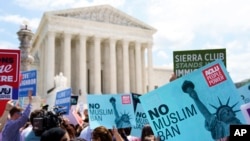Anti-Muslim hate crimes in 10 of the largest U.S. cities declined last year for the second year in a row, according to a new report from California State University at San Bernardino.
There were a total of 53 reported anti-Muslim hate crimes in cities with large Muslim populations such as New York and Los Angeles, down from 74 incidents reported in 2017, the report by the university’s Center for the Study of Hate and Extremism stated.
The 28% decline in anti-Muslim incidents last year on top of a smaller decrease in 2017 followed three years during which attacks on Muslim Americans nearly doubled to levels not seen since the attacks of Sept. 11, 2001. The offenses have ranged from harassment and assault to homicide.
Preliminary data
While cautioning that the data is preliminary, Brian Levin, director of the center and the report’s lead author, said the decline was focused mostly on larger cities where historically a disproportionate number of hate crimes take place.
Anti-Muslim hate crimes, Levin said, tend to be “cyclical,” rising as terror attacks carried out by Muslim extremists inspire a public backlash and falling when the violence subsides.
The latest drop in anti-Muslim hate crime came as the number of deaths caused by Muslim American extremist violence fell to one last year from 17 in 2017 and 54 in 2016.
By comparison, in December 2015, after a Muslim couple killed 14 people in San Bernardino in the deadliest terror attack since 9/11, anti-Muslim hate crimes jumped 300%. And five days later when then-presidential candidate Donald Trump called for a total ban on Muslims entering the country, anti-Muslim and anti-Arab bias incidents jumped even further, according to Levin.
“Around political events, particularly ones that are divisive or involve particular communities, we have to be very careful with the political rhetoric because it does translate sometimes in the minds of unstable or angry assailants into an approbation for the direction of their aggression,” Levin said.
Contributing to the decline in the number of anti-Muslim incidents reported by police departments, the FBI reinstated an anti-Arab hate crime category in 2015. Incidents previously designated as anti-Muslim are now sometimes labeled anti-Arab.
Unpublished data collected by the Muslim advocacy organization Council on American-Islamic Relations broadly confirms the latest decline in anti-Muslim hate crimes in the United States. CAIR data, cited by the California State University report, shows bias attacks on Muslims declined by more than half last year, from 300 incidents in 2017 to 134 incidents in 2018.
Decrease not recorded
Zainab Arain, national research and advocacy manager for CAIR, did not confirm the figures. But in an earlier email, she said that CAIR, unlike the FBI and the Center for the Study of Hate and Extremism, did not record a decrease in anti-Muslim bias incidents in 2017.
In fact, the group recorded a 15% increase in anti-Muslim hate crimes and a 17% jump in anti-Muslim bias incidents in 2017 from the previous year, with government agencies responsible for instigating more than one-third of the bias incidents, she said.
“This represents an almost unprecedented level of government hostility toward a religious minority within the United States, and is counter to the American value of religious freedom,” Arain wrote.
Trump administration officials reject such criticism, saying they remain committed to combating hate crime.
“I am deeply concerned about the rise in hate crimes and political violence that we have seen over the past decade,” Attorney General William Barr said at a recent Justice Department summit on combating anti-Semitism. “We must have zero tolerance for violence that is motivated by hatred for our fellow citizens whether based on race, sex, or creed.”







